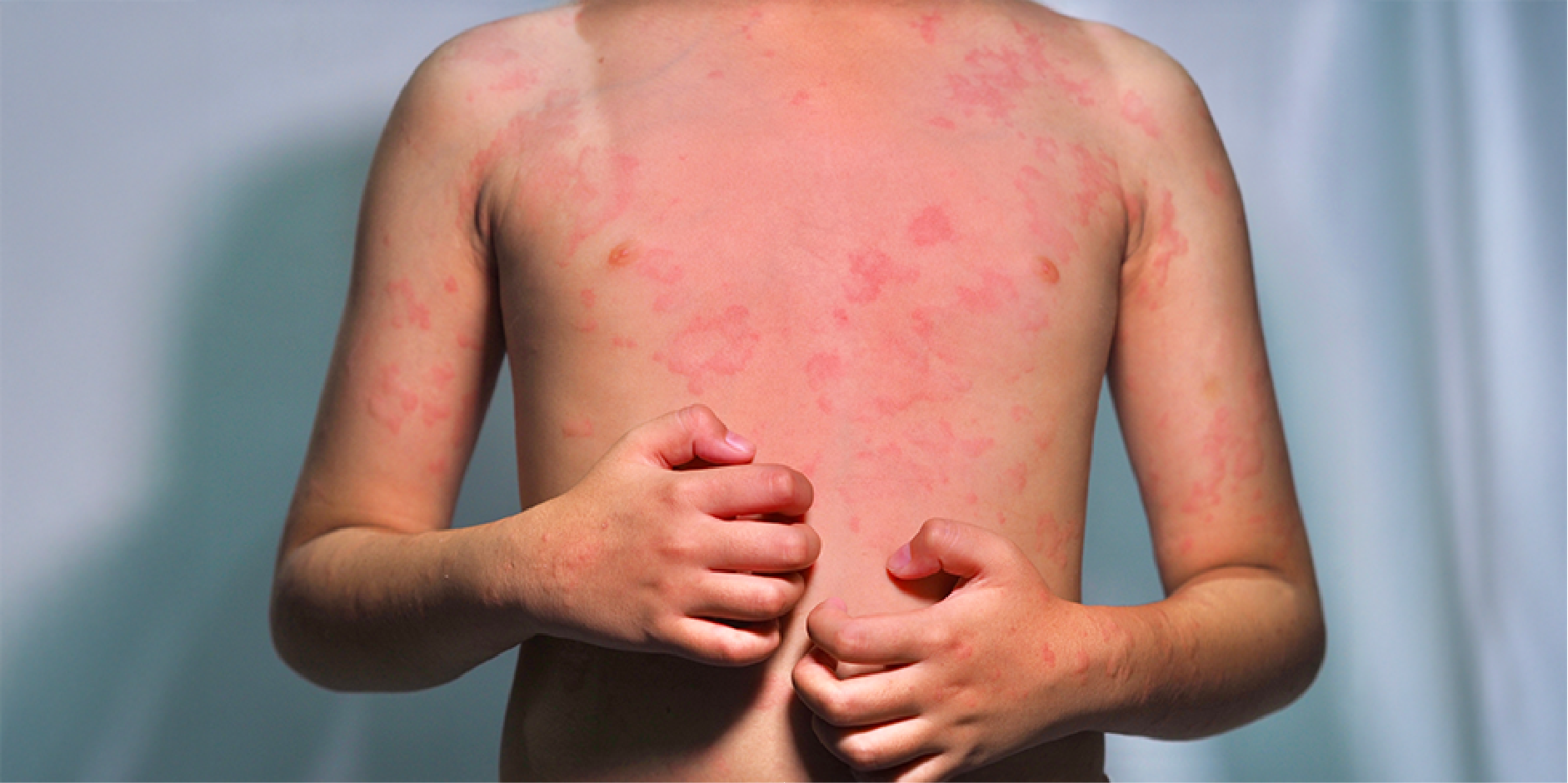Content:
Giới thiệu
Nội dung của trang này:
Giới thiệu
Dịch tễ học
Sinh lý bệnh
Nguyên nhân
Nội dung của trang này:
Giới thiệu
Dịch tễ học
Sinh lý bệnh
Nguyên nhân
Giới thiệu
Phản vệ là một phản ứng quá mẫn hệ thống hoặc toàn thân nghiêm trọng, khởi phát nhanh và có thể đe dọa tính mạng.
 Anaphylaxis (Pediatric)_Disease Background
Anaphylaxis (Pediatric)_Disease Background
 Anaphylaxis (Pediatric)_Disease Background
Anaphylaxis (Pediatric)_Disease BackgroundDịch tễ học
Ước tính tỷ lệ mắc phản vệ ở trẻ em dao động từ 1 đến 761 trường hợp trên 100.000 người-năm, với nguy cơ tái phát các phản ứng lên đến 26,5–54,0%. Dữ liệu hiện tại cho thấy tỷ lệ mắc phản vệ đang gia tăng, chủ yếu do sự gia tăng dị ứng thực phẩm ở trẻ sơ sinh và trẻ nhỏ. May mắn thay, mặc dù đã ghi nhận sự gia tăng về tỷ lệ mắc và số ca nhập viện do phản vệ, nhưng tỷ lệ tử vong vẫn thấp, dao động từ 0,05 đến 0,51 trường hợp trên một triệu người mỗi năm đối với thuốc, 0,03 đến 0,32 đối với thực phẩm, và 0,09 đến 0,13 đối với phản vệ do nọc độc gây ra.
Mặc dù hầu hết các báo cáo về phản vệ đến từ các quốc gia phương Tây, các nghiên cứu tại châu Á cũng cho thấy tỷ lệ mắc bệnh đang tăng lên tại khu vực này. Tại Hàn Quốc, tỷ lệ phản vệ ở trẻ em tăng từ 6 (năm 2008) lên 22 ca trên 100.000 người-năm vào năm 2014, đặc biệt tăng gấp bốn lần ở nhóm trẻ 0–9 tuổi. Tại Đài Loan, tỷ lệ phản vệ tăng trung bình 5% mỗi năm từ 2001 đến 2013.
Mặc dù hầu hết các báo cáo về phản vệ đến từ các quốc gia phương Tây, các nghiên cứu tại châu Á cũng cho thấy tỷ lệ mắc bệnh đang tăng lên tại khu vực này. Tại Hàn Quốc, tỷ lệ phản vệ ở trẻ em tăng từ 6 (năm 2008) lên 22 ca trên 100.000 người-năm vào năm 2014, đặc biệt tăng gấp bốn lần ở nhóm trẻ 0–9 tuổi. Tại Đài Loan, tỷ lệ phản vệ tăng trung bình 5% mỗi năm từ 2001 đến 2013.
Sinh lý bệnh
Phản vệ liên quan đến phản ứng miễn dịch qua trung gian IgE, thụ thể IgE ái lực cao, dưỡng bào, bạch cầu ái kiềm, sự giải phóng các cytokine, chemokine và các chất trung gian hóa học gây viêm (như histamine và tryptase). Các trường hợp phản vệ qua trung gian IgG đã được ghi nhận ở người sau khi sử dụng dextran hoặc kháng thể đơn dòng. Ngoài ra còn có các cơ chế không qua trung gian miễn dịch được gọi là phản vệ không dị ứng hay phản ứng kiểu phản vệ, tương đối ít gặp hơn ở trẻ em.
Nguyên nhân
Các nguyên nhân thường gặp
Dị ứng thực phẩm là nguyên nhân phổ biến nhất trong cộng đồng. Các dị nguyên thường gặp bao gồm sữa bò, lòng trắng trứng, hải sản có vỏ, đậu phộng, các loại hạt cây và lúa mì. Các loại thuốc như penicillin, beta-lactam, cephalosporin, thuốc kháng viêm không steroid (NSAID), thuốc giãn cơ, thuốc hóa trị ung thư, thuốc điều hòa sinh học, kháng thể đơn dòng (ví dụ omalizumab) và mủ cao su là những dị nguyên phổ biến trong bệnh viện.
Phản vệ do thực phẩm liên quan đến vận động thể lực thường gặp ở tuổi thiếu niên. Đặc điểm của phản vệ này là xuất hiện khi vận động diễn ra trong vòng 2 đến 4 giờ sau khi ăn một loại thực phẩm cụ thể. Phản ứng này có thể không phụ thuộc hoặc phụ thuộc vào thực phẩm; thường gặp sau khi ăn cần tây, hải sản có vỏ, và bột mì.
Phản vệ vô căn xảy ra khi không biết hay không xác định được nguyên nhân gây phản vệ dù đã khai thác kỹ tiền căn, thực hiện nghiệm pháp lẩy da với dị nguyên, đo nồng độ IgE và làm các nghiệm pháp khởi kích. Liệu pháp miễn dịch với dị nguyên và côn trùng đốt cũng là các nguyên nhân phổ biến gây phản vệ.
Dị ứng thực phẩm là nguyên nhân phổ biến nhất trong cộng đồng. Các dị nguyên thường gặp bao gồm sữa bò, lòng trắng trứng, hải sản có vỏ, đậu phộng, các loại hạt cây và lúa mì. Các loại thuốc như penicillin, beta-lactam, cephalosporin, thuốc kháng viêm không steroid (NSAID), thuốc giãn cơ, thuốc hóa trị ung thư, thuốc điều hòa sinh học, kháng thể đơn dòng (ví dụ omalizumab) và mủ cao su là những dị nguyên phổ biến trong bệnh viện.
Phản vệ do thực phẩm liên quan đến vận động thể lực thường gặp ở tuổi thiếu niên. Đặc điểm của phản vệ này là xuất hiện khi vận động diễn ra trong vòng 2 đến 4 giờ sau khi ăn một loại thực phẩm cụ thể. Phản ứng này có thể không phụ thuộc hoặc phụ thuộc vào thực phẩm; thường gặp sau khi ăn cần tây, hải sản có vỏ, và bột mì.
Phản vệ vô căn xảy ra khi không biết hay không xác định được nguyên nhân gây phản vệ dù đã khai thác kỹ tiền căn, thực hiện nghiệm pháp lẩy da với dị nguyên, đo nồng độ IgE và làm các nghiệm pháp khởi kích. Liệu pháp miễn dịch với dị nguyên và côn trùng đốt cũng là các nguyên nhân phổ biến gây phản vệ.
